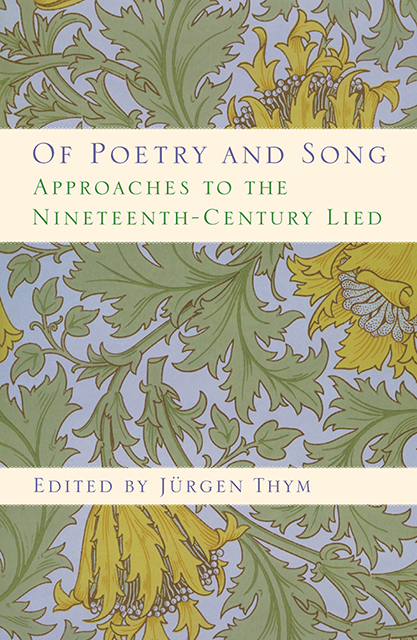Chapter Six - “Hans Adam”—Goethe’s Parodistic Creation Myth: A Parody Parodied by Hugo Wolf and Richard Strauss
Published online by Cambridge University Press: 02 March 2023
Summary
In this study I develop further an argument I have begun elsewhere, namely that in his selection of seventeen poems from Goethe's West-östlicher Divan, all of which he set to music in the second half of January 1889, Hugo Wolf has created a microcosmic mini-cycle of the poet's original macrocosmic collection of more than 220 individual poems. Here, however, my primary objective is to contrast Wolf's half-serious parodistic Lied setting of “Hans Adam” with Richard Strauss's rollicking self-parody of the same poem. But I focus as well on the intriguing fact that Wolf's setting of “Erschaffen und Beleben,” more popularly known as “Hans Adam war ein Erdenkloß,” also relates cyclically to two other poems in Goethe's Divan: “Phänomen” and “So lang man nüchtern ist.” “Phänomen” is presented in figure 6.1 in the original German, set by Wolf, as well as in John Whaley's 1974 translation.
Although “Phänomen” follows “Hans Adam war ein Erdenkloß” (fig. 6.2) in Goethe's cyclic ordering, Wolf reverses this order and “connects” the two settings by deliberately using very similar melodic motives and harmonic progressions in both. It is as if Wolf has taken his cue from the identical adverb “So” that begins the last quatrain of each poem, as is apparent in the original German of “Erschaffen und Beleben” (but not in the English equivalents of Whaley's translation).
As I have suggested, Wolf's setting of “Hans Adam” constitutes half of a cyclic pairing of two seemingly unrelated Divan poems drawn from “Buch des Sängers,” the first section in Goethe's cycle. The first poem in this linked pair of poems is his setting of “Phänomen,” or “Wenn zu der Regenwand.” This represents a notable musical achievement of “duodramatic” integration on Hugo Wolf's part; his linked settings are aesthetically analogous to what Goethe explicitly called “duodramas” in the “Buch Suleika.” By this he meant a distinctively reciprocal poetic Liebesspiel between the Oriental protagonists Hatem and Suleika. These “duodramatically” paired poems are a kind of paradox: they are autonomous and interrelated; they can be understood and enjoyed for what each says in and of itself, but their lyric essences reveal themselves most fully in amorous reciprocity and cyclic proximity.
- Type
- Chapter
- Information
- Of Poetry and SongApproaches to the Nineteenth-Century Lied, pp. 136 - 152Publisher: Boydell & BrewerPrint publication year: 2010



